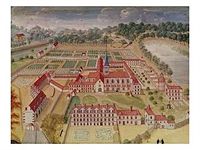Port-Royal-des-Champs
You can help expand this article with text translated from the corresponding article in French. (April 2015) Click [show] for important translation instructions.
|
48°44′39″N 2°0′58″E / 48.74417°N 2.01611°E

Port-Royal-des-Champs was an abbey of Cistercian nuns in Magny-les-Hameaux, in the Vallée de Chevreuse southwest of Paris that launched a number of culturally important institutions.
History
The abbey was established in 1204, but became famous when its discipline was reformed in 1609 by its
At the original site, several schools were founded, which became known as the
La logique, ou l'art de penser, the
The atmosphere of serious study and Jansenist piety attracted a number of prominent cultural figures to the movement, including

As a result of the Jesuit attacks on Jansenism, the schools of Port-Royal were regarded as tainted with heresy. Louis XIV wanting peace in the church, the elementary schools were forcibly closed by papal bull in 1660, following the formulary controversy. In 1661, the monastery was forbidden to accept novices, heralding its eventual dissolution. The abbey itself was abolished by a bull from Pope Clement XI in 1708, the remaining nuns forcibly removed in 1709, most of the buildings themselves razed in 1711. The chapel, containing Mère Angélique's tomb, as well as some buildings, still exist in the vast grounds of what eventually became Paris' leading maternity hospital, known as Port-Royal Hospital.
A celebrated history of Port-Royal and its influence was written by Charles Augustin Sainte-Beuve in 1837-1859.
Museums
The remains of the monastery of Port-Royal-des-Champs may still be seen at Magny-les-Hameaux, in the Chevreuse valley. Operated as Musée de Port-Royal, the 30-hectare estate includes the ruins of the abbey and its outbuildings. A 17th-century building houses the Musée national de Port-Royal des Champs, which exhibits 17th- and 18th-century paintings and engravings.
Gallery
- Abbey of Port-Royal des Champs, by Louise-Magdeleine Horthemels, c. 1709
-
Caring for the Sick
-
Distributing Alms to the Poor
-
The Sisters of the Abbey
-
General View
-
Nuns Meeting in Solitude
-
View of the Refectory
See also
- Antoine Arnauld
- Antoine Le Maistre
- Marie Angelique Arnauld
- Port-Royal Logic
- Formulary controversy
- Port-Royal Grammar
Notes
- S2CID 170394447.
External links
- Musée de Port-Royal
- Port-Royalists Published in Encyclopedia of Rhetoric and Composition (1996)






